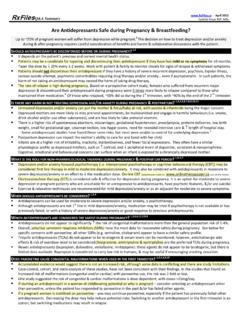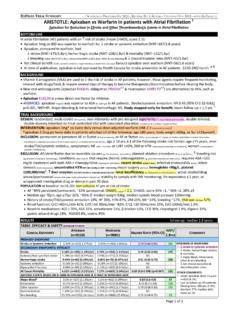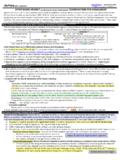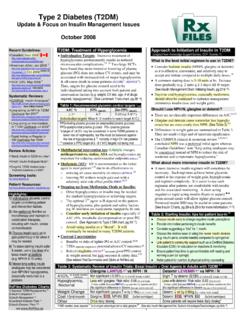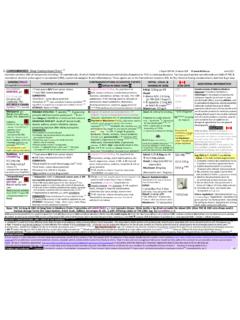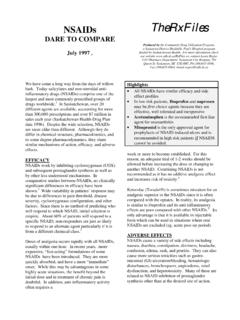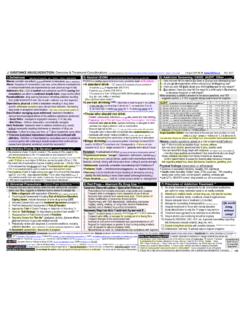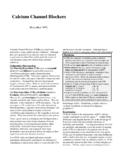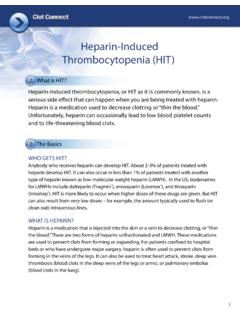Transcription of Onychomycosis Treatment - RxFiles
1 Recent Guidelines: Canadian : Bugs and drugs 2006 American : IDSA Candida guidelines 2009 UK Guideline 2003 1 Review Articles: NEJM: Fungal nail disease 2009 2 Cochrane:Topical fungal treatments of the skin & foot 2007 3 Other Resources: Images of skin diseases, includes other dermatologic links: Patient Resources: BMJ Clinical Evidence Highlights: 1) Not all abnormal nails are fungal, treat only if culture positive for dermatophyte 2) To minimize potential for false negative, culture nail clipping and deep scrapings 3) Treat with terbinafine for 12-16 weeks (drug of choice for toenail Onychomycosis ) 4) Mark nail at end of Treatment to monitor Treatment success RxFiles Related: Antifungal chart: Topical Steroid Chart: OTC Chart: Fungal Infections RxFiles Academic Detailing Saskatoon City Hospital Saskatoon, SK Canada see General Overview Onychomycosis4,5,6,7,8 Onychomycosis is a fungal infection of the nails most commonly caused by dermatophytes.
2 Less often Candida and molds may affect the nail. Onychomycosis is recognized by thickening of the distal end of the nail associated with some loosening of the nail plate from the nail bed. The nail plate shows butter yellow coloured, vertical bands starting at the distal end of the nail. Both toenails and finger nails may be affected, but dermatophyte infections of fingers seldom occur in the absence of toenail infections. Fungal infections of the foot are not life-threatening but can cause discomfort and become unsightly. For some, they predispose to recurrent cellulitis of the legs. Case discussion Mr. T., a 69 yr old man reports that his big toenail has some yellow streaks and looks different. He has a history of recurring tinea pedis. He has diabetes and is on metformin BID and a small dose of Humulin N at bedtime. He started swimming a year ago to improve his health after he had a mild heart attack.
3 Upon examination, you notice a yellowish discoloration mainly under the distal end of a thickened toenail. Risk factors for onychomycosis9 Risk factors include: age (increased risk with older age), gender males at risk than females10, history of tinea pedis or known infected family members. Medical conditions that increase risk of infection include diabetes, immunodeficiency, psoriasis or genetic factors. Other contributory factors include: poor peripheral circulation, nail trauma, occlusive shoes, smoking, sports activities or other activities involving bare feet. When to consider Treatment Patients with diabetes and/or additional risk factors for cellulitis ( prior cellulitis, venous insufficiency, edema). Onychomycosis may be a predictor of foot ulcer in a diabetic patient11. Patient experiencing nail pain or discomfort. Cosmetic improvement desired. Diagnosis Nail clippings, scrapings under the nail and deep nail samples are essential to confirm diagnosis of dermatophyte infection.
4 This is recommended before starting Treatment ! If negative for dermatophytes, assess for possible psoriasis, lichen planus, nail trauma, onycholysis ( distance runners), changes due to aging or gel nails, & yellow-nail syndrome. Oral Treatment Terbinafine LAMISIL 250mg PO once daily is the drug of choice (cure rate >50-80%, however relapse is common). Terbinafine is more effective than itraconazole12 and able to maintain cure for a longer duration (2 year follow-up).13 Terbinafine also has less risk for potential drug interactions. Alternate treatments o Itraconazole SPORANOX pulse therapy is an alternative if terbinafine contraindicated. o Fluconazole DIFLUCAN is less effective but is useful in patients unable to take the above. Duration & approach to Treatment 14,15 Duration of Treatment for terbinafine and itraconazole: toenail 12-16 weeks; fingernail 6 weeks.
5 Weekly topical terbinafine cream application after completion of oral Treatment may be tried to prevent reinfection (expert opinion). The cream is applied between toes and around nail margin. Alternate treatments o Itraconazole pulse therapy (ie. 200mg po BID for 1 week per month) may decrease costs, side effects when compared to fixed dose (ie. 200mg po daily). Cure rates are similar with pulsed vs. continuous treatments. {Continuous daily dosing is more effective than pulse therapy for terbinafine.}16 o Fluconazole 150mg po once weekly (x 6-12 months for toenail; x 3 months for fingernail).17,18 To monitor for Treatment success, mark the nail at completion of oral Treatment . This can be done by filing a line in the nail at the proximal part of known infection and marking with a permanent marker. Ask the patient to return if mark and affected toenail do not grow out or if infection moves proximal past the marked line.
6 Cautions including contraindications and side effects A meta-analysis19 found the risk of severe liver injury or asymptomatic elevations of serum transaminases with all treatments to be <2%. Liver enzymes should be done at baseline and after 4-6 weeks with terbinafine and monthly for itraconazole. Itraconazole is contraindicated in patients with heart failure or ventricular dysfunction and in patients using drugs metabolized by CYP 3A4 (see Antifungal Chart). Onychomycosis Treatment & the Antifungal Drug Chart (Chart Pages 1 & 2 printed; 3rd page available online) April 2010 Other Fungal Infections: Clinical Pearls from the Antifungal Chart (chart, next page &/or online) Common skin infections Nystatin only effective for Candida infections ( diaper rash, intertrigo, vulvovaginal infection). Combination products that contain steroids and/or nystatin should not be used for dermatophyte infections ( Viaderm : nystatin, neomycin, gramicidin & triamcinolone; Lotriderm:clotrimazole + betamethasone).
7 Oral candidiasis The nystatin dose for oral candidiasis (adult) is usually 5ml QID to ensure enough liquid to cover area in mouth Vulvovaginal candidiasis (uncomplicated) 1-3 days with a topical azole as effective as 6-7 days for Treatment but allow ~3 days for symptom resolution. 7 day topical azole Treatment recommended in pregnancy Select drug interactions with antifungals 20 Terbinafine has minimal significant drug interactions and is a good antifungal option for patients on multiple drug regimens. As an inhibitor of CYP 2D6, it does still have some potential for drug interactions including increasing the levels and effect of TCAs, beta-blockers and antipsychotics. (See also Antifungal Treatment Chart.) Itraconazole is a strong CYP 3A4 inhibitor resulting in many frequent and significant drug interactions. The majority of drug interactions result in increased levels of drugs that may: prolong QT interval ( amiodarone, quinidine, erythromycin), increase side effects (digoxin-nausea, vomiting; nifedipine-hypotension, dizziness; simvastatin/lovastatin-rhabdomyolysis; repaglinide, pioglitazone?)
8 -hypoglycemia) or increase toxicity ( cyclosporine, tacrolimus) o Strong CYP 3A4 inducers ( phenytoin, grapefruit juice) and antacids may decrease itraconazole levels. Fluconazole has less potential for major drug interactions than itraconazole because of its renal elimination and lesser effects as an enzyme inhibitor. (Agent is 3rd line in Onychomycosis due to limited efficacy.) Is ciclopirox nail lacquer Penlac an option? 21 Penetration into the nail is limited and use is of minimal value. It is slightly more effective when compared to placebo22; no additive benefit when combined with oral terbinafine23 Recurrence is common on discontinuation. Consider cost of solution: $140 / 12gm bottle The application process may be difficult for elderly & those with vision impairment. {Daily application 5mm beyond nail margin, on the bottom of the nail and skin under nail recommended. Remove weekly with isopropyl alcohol, trim or remove any damaged nail.}
9 } Treat x 48 weeks. Home remedies Do they work? Home remedies like vinegar, Listerine, Vicks Vaporub, vitamin E or thyme oil have no proven benefit. There is minimal evidence to support use of tea tree oil. It is a potent sensitizer and can cause local irritation and inflammation, producing skin reactions similar to those seen with poison Case Discussion (continued): Nail clipping and scraping was cultured and came back positive after 4 weeks. Due to patient s diabetes, potential risk for cellulitis and history of tinea pedis, it was decided to recommend pharmacological Treatment . The option of treating, including the benefits, risks and costs were discussed. Since he had diabetes, he was deemed to derive substantial benefit. Terbinafine 250mg once daily x 12 weeks was initiated Mr T. returned 3 months later after completing a course of Treatment and noticed an improvement in his toe appearance.
10 However, it still did not look normal . He was reassured that he did not require additional Treatment at this time. The nail was marked at the margin proximal to the infection and patient counseled to return if the infection moved past the mark or failed to grow out in the coming 12-18 months. He was instructed to trim & file the nail as it grew. Prevention topics to discuss with Treatment of tinea pedis Proper footwear wear sandals/slippers in communal areas such as swimming pools, locker rooms, gyms, mosque, etc. Avoid going barefoot where possible Proper nail hygiene trim nails short & straight across Avoid using same nail clippers or files on both diseased and normal nails; have separate tools for infected nails or disinfect between use Disinfection of socks & shoes Clean bathroom surfaces with bleach Coming soon .. Summer 2010: RxFiles Drug Comparison Charts book 8th Ed.
